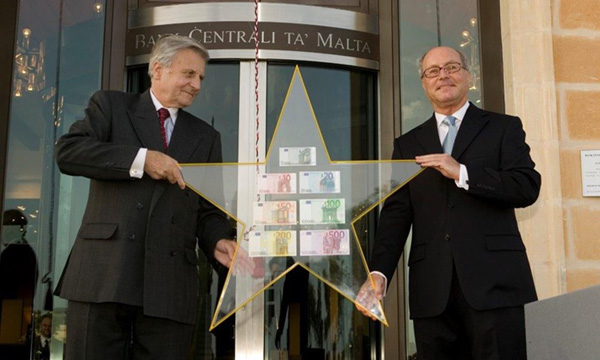Our history
Pre-1968
|
In January 1964, a United Nations mission headed by Professor Wolfgang F. Stolper submitted a recommendation to the Maltese Government to establish a central bank as it felt that there were serious gaps in Malta's financial infrastructure, particularly concerning advice to Government on financial and monetary matters.
Thus, following Independence in September 1964, the Maltese Government sought technical assistance from the Bank of England and from the International Monetary Fund to establish a central bank. In February 1967, Dr Philip L. Hogg (pictured right), a senior official of the Bank of England, arrived in Malta to carry out preliminary organisational and legislative work. Legislation was enacted on 11 November 1967 and five months later, on 17 April 1968, the Central Bank of Malta was formally established, with Dr Hogg appointed as the first Governor of the Bank.
|
 |
Between 1967 and 2008, the Bank’s operational history can be subdivided into three main periods reflecting the Bank’s evolution from an organisation carrying out central banking functions in the context of Malta’s fixed exchange rate regime to an institution forming an integral part of the Eurosystem, which sets and implements monetary policy in the countries of the euro area.
1968-1994
During this period the Central Bank of Malta mainly focused on the implementation of exchange rate policy, the management of the country’s reserves, the supervision of the banking system, the issue of currency and the provision of banking services to the government, public sector organisations and banks.
The Bank’s role in implementing exchange rate policy, which involved the imposition of exchange control, assumed particular significance in July 1972 when the Maltese currency peg to sterling was discontinued. At this point the Bank started determining the exchange rate of the Maltese lira on the basis of a trade-weighted basket of currencies. Following the enactment of the Exchange Control Act in 1972, the Bank was appointed agent for the administration of exchange control – a role which it exercised for a number of years. The Bank was also responsible for management of the country’s external reserves and was the sole buyer and supplier of foreign currency to the public sector and banks.
The Central Bank of Malta was also nominated as supervisor of the banking system in terms of the Banking Act of 1970 and, later, as supervisor of the Malta Stock Exchange in the Malta Stock Exchange Act, 1990.

13 February 1971 - The premises of the Central Bank of Malta are formally inaugurated
In September 1969 the Central Bank of Malta issued its first series of currency notes and, following decimalization in May 1972, its first series of coins. The Bank was also responsible for monitoring the Maltese Government’s cash position and for providing it with short-term credit.
1994-2002
This period was marked by a notable change in the Bank’s policy orientation as part of an overall modernisation of the financial services sector brought about by the introduction of new legislation and an extensive revision of existent laws. Following amendments to the Central Bank of Malta Act in 1994, the Bank was granted greater autonomy in formulating and implementing monetary policy. A Monetary Policy Council was set up and the Bank launched its first open market operations to move from a system of direct monetary controls and administered interest rates to a more market-oriented intervention and market-driven interest rates. The Bank was also prohibited from advancing short-term funds to Government not to undermine the effectiveness of monetary policy.
The Bank limited its foreign exchange deals with banks to three currencies to encourage development of an interbank foreign exchange market. Furthermore, all exchange restrictions on current account payments were gradually removed.
With the enactment of a new Banking Act and a Financial Institutions Act in 1994, the Bank’s role for banking supervision was confirmed after it was appointed as the Competent Authority responsible for supervision of credit and financial institutions.
2002-2007
Malta’s preparations for membership in the European Union (EU) also affected the Bank, which had to adapt to a new environment in line with the country’s forthcoming commitments. In 2002 amendments to the Central Bank of Malta Act granted the Bank full independence in the formulation and implementation of monetary policy. The amendments also ensured the security of tenure of the Governor, Deputy Governor and Board members of the Bank by stipulating five-year terms of office. Monetary policy decisions were vested in the Governor, following consultations with the Monetary Policy Advisory Council. The amendments also provided for the enactment of a framework to govern payment systems. At the same time, the Bank set up its first formal payment system in Malta compliant with international standards. Also in 2002, responsibility for the regulation and supervision of the banking and financial sector, as well as for the Malta Stock Exchange, was transferred to the Malta Financial Services Authority (MFSA). The Bank remained responsible for ensuring the stability of the Maltese financial system.
On 1 May 2004 Malta joined the EU and the Central Bank of Malta became part of the European System of Central Banks (ESCB). The Governor of the Bank began to sit on the General Council of the European Central Bank (ECB) and experts from the Bank became members of ESCB committees. All capital controls were removed.
In May 2005 Malta joined the Exchange Rate Mechanism (ERM II) whereby the Maltese lira was pegged to the euro with a central parity rate of EUR1=MTL0.429300. At the same time the Bank started its preparations for the introduction of the euro as Malta’s national currency as from 1 January 2008, with the central parity rate of the euro with the Maltese lira confirmed and set at the irrevocably fixed conversion rate.
2008
On 1 January 2008 Malta joined the euro area. The Central Bank of Malta joined the Eurosystem and was integrated within the decision-making bodies of the ECB. The Governor became a member of the Governing Council of the ECB and experts from the Bank started to participate in Eurosystem committees. Various amendments which came into force in the beginning of 2008 brought the Central Bank of Malta Act in line with requirements of the Eurosystem.
From its modest beginning in 1967 the Central Bank of Malta has thus evolved into an institution with an equal status to other national central banks of the euro area.
